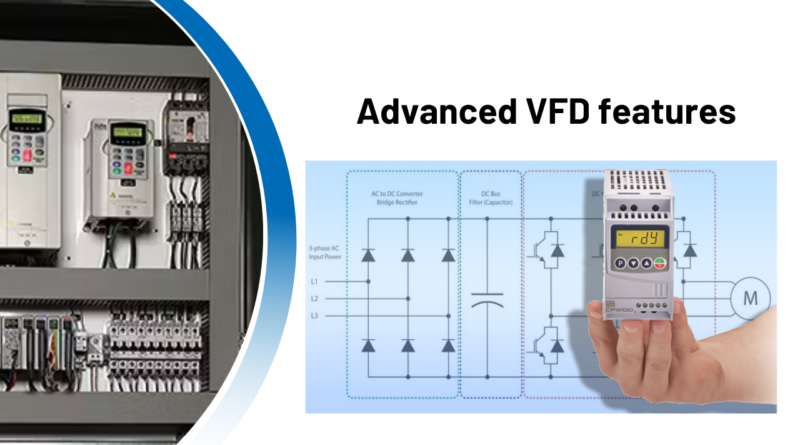Advanced VFD features
Advanced VFDs often include features that provide greater control and flexibility for the user. Here are some advanced features that are commonly found in VFDs:
Communication protocols:
Many VFDs include built-in communication protocols such as Modbus or Ethernet/IP, which allow the VFD to communicate with other devices such as PLCs, HMIs, or SCADA systems.
Communication protocols are a key feature of advanced VFDs that allow the VFD to communicate with other devices such as PLCs, HMIs, or SCADA systems. Some of the commonly used communication protocols in VFDs include:
Modbus: Modbus is a widely used communication protocol that allows the VFD to communicate with other devices such as PLCs or HMIs. Modbus is a serial communication protocol that uses a master-slave architecture.
- Ethernet/IP: Ethernet/IP is an industrial communication protocol that allows the VFD to communicate over an Ethernet network. Ethernet/IP is commonly used in industrial applications where high-speed data transfer is required.
- DeviceNet: DeviceNet is a communication protocol that is commonly used in industrial automation applications. DeviceNet is a multi-master, serial communication protocol that allows the VFD to communicate with other devices such as sensors or actuators.
- Profibus: Profibus is a communication protocol that is commonly used in process automation applications. Profibus is a serial communication protocol that allows the VFD to communicate with other devices such as sensors, actuators, or HMIs.
- CANopen: CANopen is a communication protocol that is commonly used in embedded systems and industrial automation applications. CANopen is a serial communication protocol that allows the VFD to communicate with other devices such as sensors, actuators, or HMIs.
Programming options:
Some VFDs include programming options that allow the user to customize the operation of the VFD. This can include the ability to create custom functions or algorithms, or to write scripts that automate certain tasks.
Programming options are an advanced feature of VFDs that allow the user to customize the operation of the VFD. Here are some programming options commonly found in VFDs:
- Custom functions: VFDs can include the ability to create custom functions that can be used to automate certain tasks. For example, a custom function could be used to ramp up the motor to a specific speed when a certain input signal is received.
- Algorithms: Some VFDs include the ability to write custom algorithms that can be used to control the motor speed and torque. This can allow the user to create custom control strategies for specific applications.
- Scripts: VFDs can also include the ability to write scripts that can automate certain tasks. For example, a script could be used to turn the motor on or off at a specific time of day.
- Timers and counters: VFDs often include timers and counters that can be used to control the operation of the VFD. For example, a timer could be used to turn the motor off after a certain amount of time has elapsed.
- Logic functions: VFDs can include logic functions such as AND, OR, and NOT gates, which can be used to control the operation of the VFD based on certain input signals.
- Data logging: Some VFDs include the ability to log data such as motor speed, torque, and power consumption. This can be useful for monitoring the performance of the motor and identifying potential issues.
Motor parameter identification:
Some VFDs include motor parameter identification features, which allow the VFD to automatically detect the motor parameters and set the appropriate VFD parameters accordingly.
- Motor voltage: The VFD must be configured to match the voltage of the motor being used. This is typically stated on the motor nameplate.
- Motor current: The maximum current that the motor will draw must be identified so that the VFD can be properly sized. This is typically stated on the motor nameplate.
- Motor speed: The maximum and minimum speeds of the motor must be identified so that the VFD can be configured to operate within these limits.
- Motor frequency: The VFD must be configured to output the correct frequency to the motor. This is typically stated on the motor nameplate.
- Motor power: The VFD must be properly sized to handle the power requirements of the motor. This is typically stated on the motor nameplate.
- Motor efficiency: The efficiency of the motor must be identified so that the VFD can be properly configured to optimize energy savings.
- Motor inertia: The inertia of the motor and any attached load must be identified so that the VFD can be properly configured to control the motor speed.
Energy savings optimization:
Some VFDs include energy savings optimization features, which analyze the load on the motor and adjust the VFD parameters to optimize energy savings.
Sensorless vector control:
Some VFDs include sensorless vector control, which provides greater precision and control over the motor speed and torque.
Harmonic mitigation:
Some VFDs include harmonic mitigation features, which reduce the amount of harmonic distortion caused by the VFD.
Safety features:
Some VFDs include advanced safety features such as fault detection and protection, motor overload protection, and ground fault protection.
In summary, advanced VFDs often include features that provide greater control and flexibility for the user, including communication protocols, programming options, motor parameter identification, energy savings optimization, sensorless vector control, harmonic mitigation, and safety features. These features can help to improve the performance, efficiency, and reliability of the VFD and the motor system.




